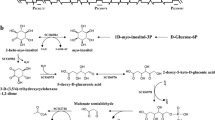Abstract
TheBacillus subtilis gnt operon is negatively regulated via interaction of thegnt repressor (GntR) with an operator upstream ofgntR, which is antagonized by gluconate. An 8 bp insertional operator mutation (gntOi) of thegnt operon was constructed which affected the expression level of this operon. Two suppressors of thisgntOi mutation, exhibiting normal expression, were also isolated; one involved a threonine substitution for the Ala-48 residue (gntR48T) within the helix-turn-helix DNA-binding motif of GntR, and the other an adenine substitution for the guanine at nucleotide — 4 within thegntOi operator (gntOiM4A) (+1 is the transcription initiation site). ThegntR48T mutation by itself rendered thegnt operon partially constitutive. When thegntR43L mutation, which renders thegnt operon fully constitutive, was introduced into thegntOi orgntOiM4A mutant, the operator mutations were found not to affect the promoter activity of thegnt operon. These in vivo results indicate that thegntOi mutation affects the operator interaction with GntR, causing a low expression level even in the presence of gluconate. In vitro gel retardation and DNase I footprint analyses demonstrated that even when gluconate was present, GntR still bound to thegntOi operator region.
Similar content being viewed by others
References
Allison SL, Phillips AT (1990) Nucleotide sequence of the gene encoding the repressor for the histidine utilization genes ofPseudomonas putida. J Bacteriol 172:5470–5476
Brennan RG, Matthews BW (1989) The helix-turn-helix DNA binding motif. J Biol Chem 264:1903–1906
Dahl MK, Dengenkolb J, Hillen W (1994) Transcription of thexyl operon is controlled inBacillus subtilis by tandem overlapping operators spaced by four base-pairs. J Mol Biol 243:413–424
DiRusso CC, Metzger AK, Heimert TL (1993) Regulation of transcription of genes required for fatty acid transport and unsaturated fatty acid biosynthesis inEscherichia coli by FadR. Mol Microbiol 7:311–322
Fujita Y, Freese E (1981) Isolation and properties of aBacillus subtilis mutant unable to produce fructose-bisphosphatase. J Bacteriol 145:760–767
Fujita Y, Fujita T (1983) Genetic analysis of a pleiotropic deletion mutation (Δigf) inBacillus subtilis. J Bacteriol 154:864–869
Fujita Y, Fujita T (1987) The gluconate operongnt ofBacillus subtilis encodes its own transcriptional negative regulator. Proc Natl Acad Sci USA 84:4524–4528
Fujita Y, Fujita T (1989) Effect of mutations causing gluconate kinase or gluconate permease deficiency on expression of theBacillus subtilis gnt operon. J Bacteriol 171:1751–1754
Fujita Y, Miwa Y (1989) Identification of an operator sequence for theBacillus subtilis gnt operon. J Biol Chem 264:4201–4206
Fujita Y, Miwa Y (1994) Catabolite repression of theBacillus subtilis gnt operon mediated by the CcpA protein. J Bacteriol 176: 511–513
Fujita Y, Fujita T, Miwa Y, Nihashi J, Aratani Y (1986a) Organization and transcription of the gluconate operon,gnt, ofBacillus subtilis. J Biol Chem 261:13744–13753
Fujita Y, Nihashi J, Fujita T (1986b) The characterization and cloning of a gluconate (gnt) operon ofBacillus subtilis. J Gen Microbiol 132:161–169
Haydon DJ, Guest JR (1991) A new family of bacterial regulatory proteins. FEMS Microbiol Lett 79:291–296
Lawson CL, Carey J (1993) Tandem binding in crystals of atrp repressor/operator half-site complex. Nature 366:178–182.
Kawamura F, Wang L-F, Doi RH (1985) Catabolite-resistant sporulation (crsA) mutations in theBacillus subtilis RNA polymerase σ43 gene (rpoD) can suppress and be suppressed by mutations inspoO genes. Proc Natl Acad Sci USA 82:8124–8128
Maxam AM, Gilbert W (1980) Sequencing end-labeled DNA with base-specific chemical cleavages. Methods Enzymol 65:499–560
Miwa Y, Fujita Y (1988) Purification and characterization of a repressor for theBacillus subtilis gnt operon. J Biol Chem 263: 13252–13257
Nihashi J, Fujita Y (1984) Catabolite repression of inositol dehydrogenase and gluconate kinase syntheses inBacillus subtilis. Biochem Biophys Acta 798:88–95
Pabo CO, Sauer RT (1984) Protein-DNA recognition. Annu Rev Biochem 53:293–322
Phillips SEV, Manfield I, Parsons I, Davidson BE, Rafferty JB, Somers WS, Margarita D, Cohen GN, Saint-Girons I, Stockley PG (1989) Cooperative tandem binding ofmet repressor ofEscherichia coli. Nature 341:711–715
Quail MA, Guest JR (1995) Purification, characterization and mode of action of PdhR, the transcriptional repressor of thepdhR-aceEF-lpd operon ofEscherichia coli. Mol Microbiol 15:519–529
Quail MA, Dempsey CE, Guest JR (1994) Identification of a fatty acyl responsive regulator (FarR) inEscherichia coli. FEBS Lett 356:183–187
Saito H, Miura K (1963) Preparation of transforming deoxyribonucleic acid by phenol treatment. Biochem Biophys Acta 72:619
Sanger F, Nicklen S, Coulson AR (1977) DNA sequencing with chain terminating inhibitors. Proc Natl Acad Sci USA 74: 5463–5467
Schaeffer P, Ionesco H, Ryter A, Balassa G (1965) La sporulation deBacillus subtilis: étude génétique et physiologique. Int CNRS 124:553–563
Titgemeyer F, Reizer J, Reizer A, Tang J, Parr TR Jr, Saier MH Jr (1995) Nucleotide sequence of the region betweencrr andcysM inSalmonella typhimurium: five novel ORFs including one encoding a putative transcriptional regulator of the phosphotransferase system. DNA Sequence 5:145–152
Yanisch-Perron C, Vieira J, Messing J (1985) Improved M13 phage cloning vectors and host strain: nucleotide sequences of the M13mp 18 and pUC19 vectors. Gene 33:103–119
Yoshida K, Fujita Y, Sarai A (1993) Missense mutations in theBacillus subtilis gnt repressor that diminish operator binding ability. J Mol Biol 231:167–174
Author information
Authors and Affiliations
Additional information
Communicated by M. Sekiguchi
Rights and permissions
About this article
Cite this article
Yoshida, KI., Miwa, Y., Ohmori, H. et al. Analysis of an insertional operator mutation (gntOi) that affects the expression level of theBacillus subtilis gnt operon, and characterization ofgntOi suppressor mutations. Molec. Gen. Genet. 248, 583–591 (1995). https://doi.org/10.1007/BF02423454
Received:
Accepted:
Issue Date:
DOI: https://doi.org/10.1007/BF02423454




